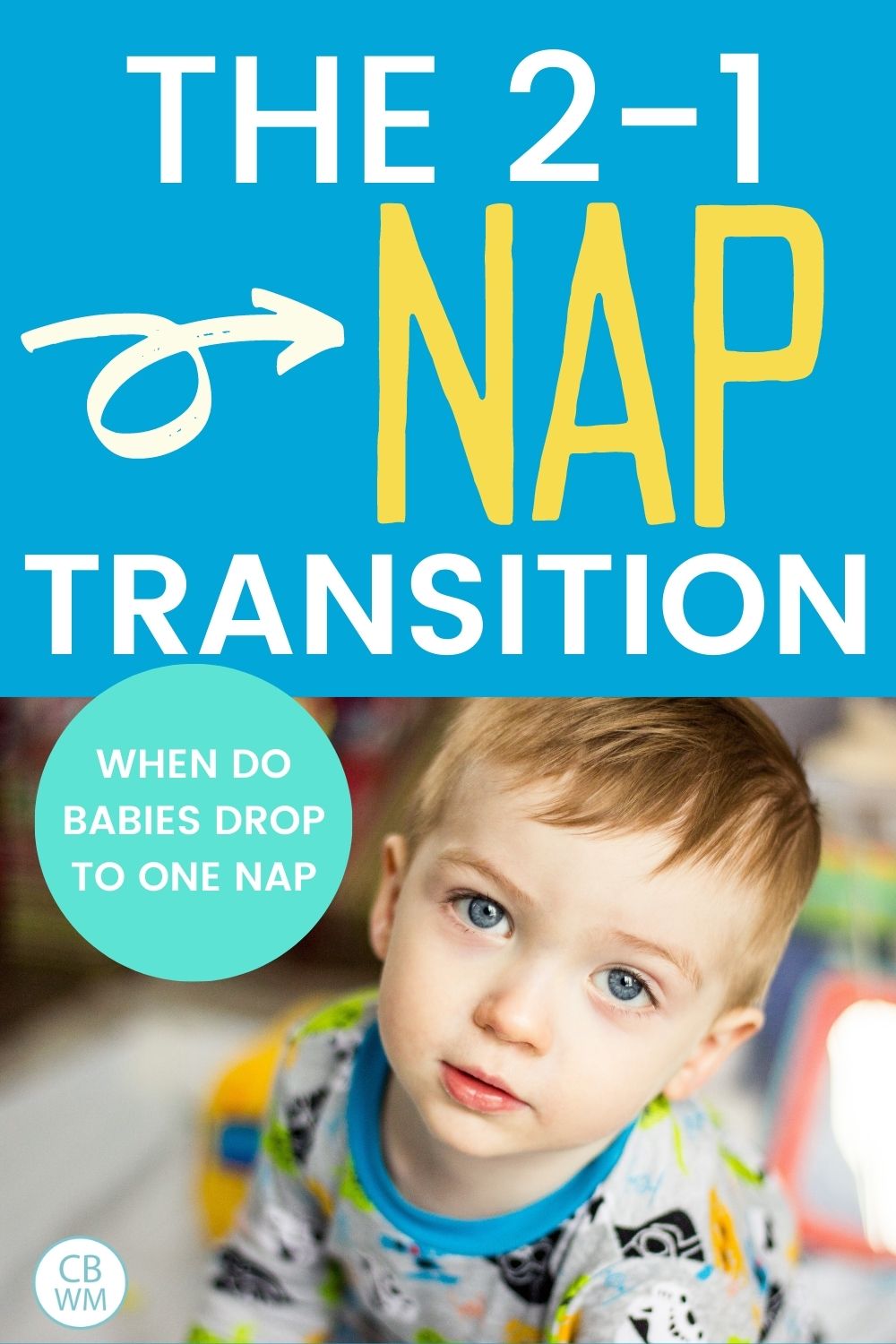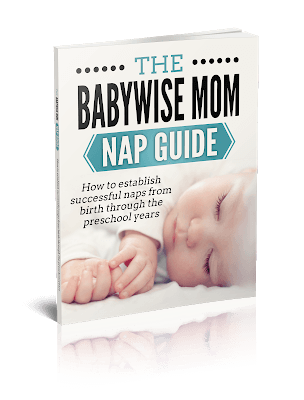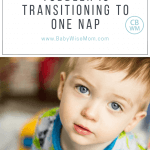Signs your toddler is ready getting to transition to one nap. Toddlers are usually not quite ready to drop the morning nap all at once, but have some transition time. This post outlines what to do with naps during the transition.

It is a frustrating situation.
Your little one does not need two naps. When he takes two naps, he doesn’t really take two naps OR he doesn’t sleep as well at night and you have night waking.
But he isn’t ready for just one nap, either. When he takes one nap, he is a terror and also does not sleep as well at night because he is overly tired.
For many toddlers, there is a “transition time” where the child is not really ready to drop the morning nap, but also does not really need two full naps every day.
I call this the 2-1 nap transition time. You are in between a one nap schedule and a two nap schedule.
This never happened with Brayden; he was pretty textbook. He continued sleeping well for his morning nap but not well for his afternoon nap. That is how I knew he was ready to drop the morning nap. We dropped it cold turkey at 17 months and he did just fine.
>>>Read: Dropping Naps: A Quick Reference
Kaitlyn, my second child, experienced this transition time.
When Kaitlyn was about 14 months, she started to not sleep well for both naps.
This was extremely odd to me. She had always been a really good napper. She loved to sleep. It was so odd that her daytime sleep was suddenly suffering.
I started to wonder if perhaps she was ready to drop the morning nap already. It surprised me because she didn’t drop her third nap until she was 11 months old (which is way beyond the typical 8 months old).
I was sure based on past history she would be an older toddler when she was ready to drop her morning nap and transition to one nap a day. The older age for this nap transition is 18-22 months, and I thought that is where she would be.
Kaitlyn missed her morning nap once a week for church. She would then come home, eat lunch, and go to sleep for about 4 hours–making up for her missed morning nap.
She was very, very tired when we got home.
Tired enough that she usually didn’t eat her lunch very well. Based on this, I figured she wasn’t really ready to drop her morning nap and switch to one nap a day.
I felt confused and unsure of what to do, which I am sure is how you are feeling! Let’s get some information for you so you can get an action plan moving forward.
Post Contents
When do Babies Drop to One Nap
The big question is WHEN do babies drop to one nap? What is the typical age?
The age range is wide. It can be as young as 14 months and as old as 22 months. Most toddlers do this around 18 months old.
If your baby is younger than 14 months old, do not drop the morning nap (more on that at the end of this post). If your toddler is 22 months or older, start to work toward dropping to one nap a day.
Transition to One Nap Methods
There is a possibility that for some children, this nap problem in the young toddler months is just a phase.
Maybe it is teething. Maybe it is all of the new skills and abilities he is getting as he gets older. Maybe it is curiosity. Perhaps it is sleep regressions.
I suggest you rule these things out before you start to tweak awake time, nap times, and nap schedules.
Do not just assume some poor sleep means it is time to shift the schedule. There are a lot of reasons for short naps. Read Common Reasons for Poor Sleep to rule out the basics before moving forward with dropping the nap and pursuing the 2 to 1 nap transition.
>>>Read: 5 Ways Season Changes Disrupt Your Child’s Sleep
With that said, here are some methods that work to transition to 1 nap and just have that second nap of the day, dropping the morning nap.
Shorten the Morning Nap
The first thing you can do is to shorten the morning nap.
Back to the Kaitlyn story, I started lengthening Kaitlyn’s morning waketime before her morning nap and still waking her up from nap at the same time. So, I shortened the morning nap.
I also added about 10-15 minutes to her waketime between her two naps, so I added awake time.
These actions fixed things and she was back to sleeping for both naps: 1.5 hours in the morning and 2-2.5 in the afternoon. Her day sleep total was shorter and her time awake was longer. She had one really good nap each day.
For some children, this morning nap might need to be shortened more than what I did for Kaitlyn. One hour naps in the morning might be more appropriate.
As I said, Kaitlyn is a sleeper. At 18 months, she was still taking a long morning nap. In other words, she was on a 2 nap schedule (even though the morning nap was shorter than it had been).
Weaning Process
Some children might be able to go to a “weaning” process at this point (see Dropping a Nap: A Weaning Process). This means you drop the morning nap in a weaning fashion. If so, you would play the morning nap by ear. That means you don’t always have a first nap.
Some days your little one might take a morning nap. Other days you might not do a morning nap and just have one nap.
If you want to do a weaning process to drop the nap, you will want to start slowly.
You might start off with an every-other-day approach. One day two naps, the next day just one nap. Or you might do two days of two naps and one day of one nap. Decide how slowly you need to take it for your toddler.
Pay attention to your child’s sleep cues around bedtime. Your kiddo might need an earlier bedtime on days there is no morning nap, at least for a little while. You will likely need to push bedtime up a little for a short period while your toddler adjusts to less daytime sleep.
>>>Read: What To Do When Your Toddler Cries at Nap Time
Testing to See if Toddler is Ready for One Nap
When Kaitlyn was 18 months old, I decided I wanted to test and see if we could drop to one nap a day consistently.
As I said, she missed her morning nap every Sunday for church. One week she also missed her morning nap for her 18-month well-baby doctor appointment.
I thought that was a good opportunity to test to see if she was ready to drop the morning nap. I really wanted the morning nap to be dropped for the holidays; it really makes things like errands and visiting friends and family much easier to have just one nap to work around.
At that point, Kaitlyn handled her missed morning nap once a week really well. She was perfectly happy at church and at home. However, day two was a bit different. She was still happy, but as lunch approached she got to be more clingy than usual with me.
As we ate lunch (at about 11:30), she put her head down on her tray and continued to eat. I asked her if she was tired. She replied “uh-huh” and then rubbed her eyes to show me.
At that point in the day, I knew she just wasn’t ready to drop her nap every day. She couldn’t handle two days in a row. The next day, she was more tired than usual all day. We stuck with the two-nap schedule.
>>>Read: How To Solve Sleep Problems for Toddlers and Preschoolers
Sometimes you have to just try things out with your schedule. Just drop the nap and see what happens. If it doesn’t go well, add it back in and try again some other time.
Watch for Overtiredness
As you test this process, watch for overtiredness. If your toddler does not sleep well for naps and/or night-time after you start to make some adjustments, you probably need to add some daytime sleep back into the routine.
If you toddler gets too much sleep, she won’t sleep well. But if she doesn’t get enough sleep, she also will not sleep well.
Moving To One Nap Adjustment Period
Don’t mistake needing to adjust for not being ready.
Most children will take about a week to adjust to not having a morning nap. Some will be able to adjust faster and will be adjusted in a few days. Others might need a couple of weeks to get adjusted.
That means your toddler will either be more cranky or more tired as lunchtime approaches. You might have to push through the crankiness and tiredness and let your child adjust.
So how did I know Kaitlyn truly was not ready and it wasn’t that she simply needed to adjust?
I just knew.
It isn’t something I can put my finger on.
Always trust your instinct. Sometimes you will be wrong, but give your instinct a try and see if it is right.
Because Kaitlyn was as flexible as she was, I was pretty sure she could have dropped her morning nap at 18 months and survived. She wasn’t a cranky type. Emotionally, I could handle her.
However, she would not have been operating at 100% yet. That is what I want for her. I wanted her waketimes to be spent learning and growing, not sitting in a zombie-like state for an hour or two.
Transition to One Nap: Give it a Try
If you think your child is ready to drop the morning nap, you can always give it a try. My guess is after two-three days in a row, you will have a good idea if he is really ready or not. Do be aware of a sleep deficit and what that looks like so you can be watching for that with your child.
I suggest doing so while having other things to do. Errands to run, people to visit, etc. I suggest that for the child who doesn’t necessarily like sleep. For Brayden, if I had tried dropping the morning nap with him just at home, he would have quickly insisted that is the way things are done from now on, ready or not.
Not to say that is what I would have had to do (I am the parent), but he would have “seen the light” so to speak and would have tried to skip naps every day.
For Kaitlyn, it would have been okay to try just being at home. She would have most happily gone back to sleeping in the morning anyway.
Keep in mind that children will have an easier time staying awake if they are out and being stimulated rather than the same old scene at home, but after a couple of days, signs will being to show of yes, he can handle this or no, he still needs some sleep in the morning.
>>>Read: How To Fill Toddler’s Time When Transitioning to One Nap
If your child is transitioning right now, take heart that it is a fairly common thing. He is not abnormal by doing so. If he is transitioning, try one or more of the following:
- First look into other possible reasons for the poor sleeping. Teething, cold, growth spurt, simply curious, etc.
- Try shortening your morning nap and lengthening waketimes.
- Once you know (or suspect) the nap is ready or about ready to be dropped, try weaning from the nap if desired.
- If you aren’t sure if the nap is ready to be dropped but think it might, give it a try for 1-3 days and see how it goes.
- Just live with the poor naps for a bit until he is fully ready to drop the nap. It won’t last forever!
>>>Read: Dropping the Morning Nap Full Guide
Your 10 Month Old Needs Two Naps
It is very common for 10 month olds to have some nap issues. Short naps will happen. Many parents get some nap troubles at 10 months and decide to drop the morning nap.
This is not your answer.
One day when Kaitlyn was 10 months old, Kaitlyn’s morning naps got shorter. Now, I don’t want to complain. They went from 2.5 hours to 1.5 hours. Nothing to complain about, but she was waking an hour early for the next feeding.
So I did some troubleshooting. I figured she was ready for a longer waketime in the morning.
For some reason, I bumped it up 30 minutes. That really isn’t the smartest way to go–but I did it. It was not the answer. The nap went to one hour instead.
So I backed it off so we were bumped to 20 minutes longer waketime. Still not the answer. I then did 10 minutes. Nope. So I tried 15. Yes! That did it. It is amazing what a difference those 5 minutes made.
This solution has been confirmed a few times for me.
One morning she and I were playing ball for the first time. She was getting a kick out of it! She was laughing and squealing! I lost track of time and put her down 10 minutes late. A short nap followed.
Don’t underestimate the power of finding the right timing. If your baby doesn’t have obvious sleep cues, it is going to take you some trial and error to find that magic minute.
Do not assume early waking means it is time to drop a nap and move to a one-nap schedule.
Conclusion
This can be a frustrating time. Do not let it stress you out. The schedule is not ruined forever. Find a solution to get you through and then wait it out. Your little toddler will be ready for just one nap a day before too long.
Related Posts
See these posts for more on dropping naps:
- Dropping the Morning Nap Guide
- Dropping a Nap: A Weaning Process
- Everything You Need to Know About Dropping Naps
- Dropping the 3rd Nap (evening)
- Going To Church Without Ruining Your Baby’s Sleep
If you need help with naps, be sure to check out The Babywise Mom Nap Guide. Get your copy of the eBook in instant download.

This post first appeared on this blog in October 2008



